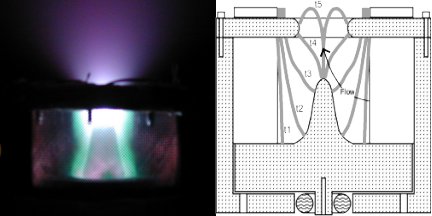Ablative Z-Pinch Pulsed Plasma Thruster (AZPPT)

Introduction
The ablative Z-pinch pulsed plasma thruster (AZPPT) is an electric propulsion device that takes the Z-pinch configuration from gas-fed devices and fuses it with the ablative pulsed plasma thruster. Experiments recently done at the Electric Propulsion and Plasma Dynamics Lab (EPPDyL) show that this device holds some promise as an effective thruster.
Typically in a Z-pinch, an arc is struck across the face of the propellant to ablate it and the JxB Lorentz force squeezes the plasma down to a thin column of plasma, relying on the gasdynamic pressure gradient to extract directed kinetic energy from the plasma column. The AZPPT device currently under investigation uses a novel spike anode design. This design is based on work performed at EPPDyL showing that current sheets in PPT’s move faster along the anode than the cathode. As such, the Z-pinch thruster’s current sheet starts out pinching cylindrically and evolves into a current sheet travelling in the axial direction, accelerating the plasma in the desired direction. (see picture below) Preliminary results indicate that the spike anode design is more effective at extracting directed kinetic energy from the plasma than simply relying on the gasdynamic pressure gradient that comes about from the pinch.
This thruster is attractive for several reasons. First, it has no moving parts and requires no additional propellant tank or fuel feed lines/valves. This makes it a relatively simple and rugged device. All that is needed are propellant (Teflon), a capacitor, the discharge chamber, and spark plugs to initiate the discharge. Also, this thruster has a thrust-to-power (T/P) ratio of around 28 microN/W and thrust efficiencies up to 7.5%. This high T/P ratio means this thruster could potentially be used to perform high slew rate satellite manuevers without using a great deal of power.
Using a modified thruster with a clear Plexiglas propellant bar, preliminary photographs of the discharge were obtained. These photographs were taken with an Imacon fast-framing camera at 500 kHz and a Nikon Coolpix digital camera which shows the discharge integrated for all time.
Accomplishments
This thruster has been considered to be placed on a Russian satellite for the COMPASS P3OINT experimental mission. Design work is underway to modify the AZPPT design to mate with the COMPASS satellite.

Relevant Publications
- Ablative Z-pinch pulsed plasma thruster - 36th Joint Propulsion Conference (2000)
- Performance Study of the Ablative Z-pinch Pulsed Plasma Thruster - 37th Joint Propulsion Conference (2001)
- Measurement and Control of the Current Waveform in an Ablative Z-pinch pulsed plasma thruster - Junior Paper, Physics and MAE Departments (2000)
Contact
Former students:- Tom Markusic
- Kurt Polzin
- John Ziemer
- Jack Berkery
- Christine A. McLeavey
